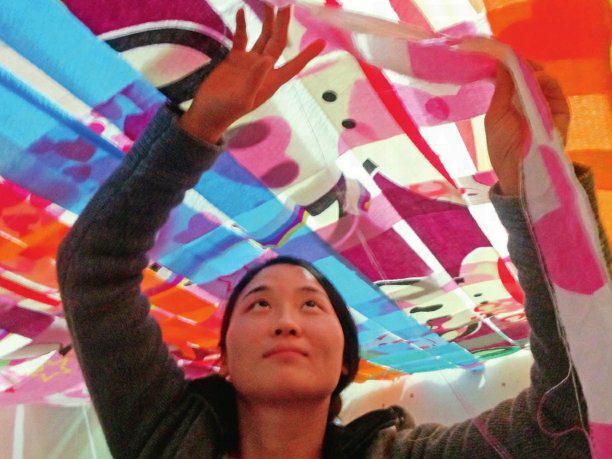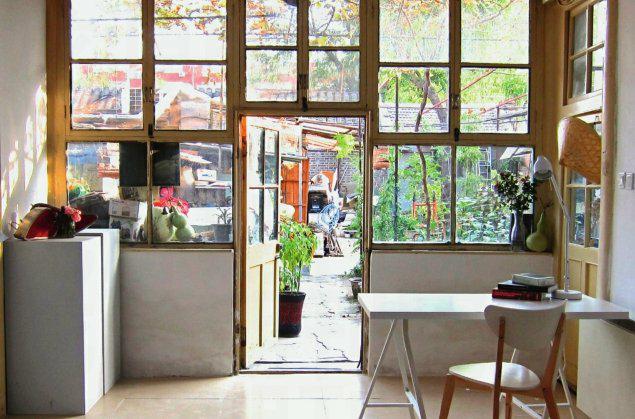Room for Creativity–Beijing’s Independent Art Scene in Motion
By+staff+reporter+VERENA+MENZEL
AN icy wind blows through the streets of Beijing as we head for the northeastern part of the capital. We are driving to a neighborhood called Cuigezhuang, which lies in Chaoyang District beyond the Fifth Ring Road. Our destination is the Dongxindian residential area, far from the city center. Its inhabitants are mainly people from other places, and those on low incomes. There are many quarters like Dongxindian in the metropolitan suburbs.
We drive through a street of the kind that most foreign visitors to the capital might never catch sight of. It is permeated with the unruly yet fleeting charm of small Chinese provincial towns. Nothing here is in any way reminiscent of the modern building complexes in Beijings central business district around the China World Towers, or of the freshly painted historical tourist attractions throughout the city, even though they are just a couple of kilometers away. That here of all places is the site of the“Apartment of Dreams Come True” seems nothing less than utopian.
Through a shabby backyard and up a flight of bare concrete stairs we reach the building that bears our destinations address. One uniform apartment door closely follows the next on the long, dark corridor. Door number B237 is purported to be the one behind which this mysterious apartment, in which dreams are said to come true, is located.
As we enter the room we see that the already small studio apartment is divided into two levels by a dense braid woven from strips of colorful bed sheets. It separates the room into upper and lower levels.
Stooping, we make our way directly to Sun Shaokun, a young Chinese artist from Beijings neighboring province of Hebei. She installed the patchwork quilt in the apartment as a room divider. We all squat in the lower, darker half of the room while talking to her about her artwork, as multi-colored shafts of light from the ceiling light above speckles our faces and clothes.
Thirty-four-year-old Sun designed and created the room divider, this unique piece of installation art, in and specifically for the “Apartment of Dreams Come True,” although the cramped space of this suburban apartment seems worlds apart from the concept of a dream house. The plaster on the walls in this spartanly furnished studio is flaking off, and at the rear are a grubby kitchenette and a small toilet in need of repair.
“Its mostly poorer people that live in this area, and my artwork is connected specifically to the aesthetics of that social class,” Sun says. She chose simple, cheap bed sheets, RMB 15 each, or around two Euros, as the raw material for her installation.endprint
“I want my work to express a feeling of constraint. Dividing the room into lower and upper spheres also implies to me a certain social meaning,” Sun explains. She goes on to emphasize that the realization of this piece of work connects closely with the “Apartment of Dreams Come True” as space for creation.
Song Xi and Yang Xinjia, two young Chinese artists both born in 1983, provide this place of creation for Sun and other contemporary, mostly young artists. The two friends started their project in No- vember 2014. Through their “Apartment of Dreams Come True” they want to create a space in which independent artists from China and abroad can work on and bring to fruition their own ideas, they told us.
When Song and Yang first met via the Internet some years ago, Song was working in Beijing in North China and Yang was living at the other end of the country in Southern Chinas Guangdong Province. In 2012 they jointly decided to devote their lives to their passion for art. Both quit their jobs in design and advertising and embarked on independent, non-commercial art projects, like the “Apartment of Dreams Come True.”
Song and Yang rented the small apartment in the Dongxindian area for three months, from November 2014 till January 2015. During this time, they invited Chinese and foreign artists to live and work in this special environment for the duration of one week each.
“The apartment serves as a work and exhibition space all in one,” Song explained. “In the end, all we offer the artists is a simple platform on which to actualize their ideas and get in touch with and interact with this particular location and its surroundings. What will finally come out of it even we dont really know.”
The two friends chose Dongxindian as the location for their art project because many people from all parts of China are gathered in this area. “This place has a representative nature for a significant section of Beijings population. There are many residential areas like Dongxindian in the city outskirts where the percentage of outsiders is very, very high. Many artists also come to the capital from other parts of China,” Song said.
Providing an independent and non-commercial room for young contemporary artists is the key concept behind the two Chinese friends project. This room is a rare good that in the 20-million-inhabitant metropolis of Beijing would be otherwise out of the question. Beijings young art scene is also confronted with this reality and strongly influenced by it.endprint

German curator Antonie Angerer, 28, has studied art history and Sinology in Germany, speaks fluent Chinese, and supports Song and Yangs project. With her former fellow student, 27-year-old German Anna-Viktoria Eschbach, Angerer herself opened an independent art and exhibition space in Beijing, the“I: Project Space,” in August 2014. It is located in a traditional Chinese courtyard in the unadulterated hutong area around Beixinqiao at the heart of the “old Beijing” within the Second Ring Road.
“Our project mainly consists of three parts,” Angerer said. “In addition to a non-commercial exhibition space we also organize an ‘artist in residenceprogram that involves inviting a new artist to stay with us every three months here in the courtyard to work and create in the heart of Beijings hutong. Apart from that, we maintain a general platform for artistic and cultural exchange through which to organize events such as workshops or artists talks.”
According to Angerer, the “I” in “I: Project Space” represents the three attributes “independent,” “international” and the Chinese character 艺(yì) for “art.” These three also form the core idea of= the project the two Germans initiated.
Like Song and Yang, Angerer and Eschbach want to give young artists in Beijing a chance to organize exhibitions exclusive of the pressure of the art market and to realize their own projects.
In comparison to Europe, China offers far less scope for artists to apply for financial support, Angerer said. “Although Beijing today has quite a diverse art scene, non-commercial exhibition spaces are still hard to find. Most of the artistic exhibitions are overtly sales-oriented.”
Nowadays, exchange platforms such as independent art spaces or resident programs can be found in more and more places throughout the world. Berlin alone, for example, contains more than 150 non-commercial art spaces, Angerer said. Beijing and other Chinese cities, however, still lack such opportunities.
“I think the support of non-commercial exhibition spaces or resident programs is crucial, especially for young artists. Its mainly they that must juggle opportunities to creat their art with financing it in order to realize their ideas. During the three months an artist stays here with us at ‘I: Project Space” he or she can fully concentrate on his or her work and the creative process.” And there is in China great interest in projects like this, not only on the part of Chinese artists, but also of foreigners.endprint
Both projects, “I: Project Space” and the “Apartment of Dreams Come True,” bring artists directly to the midst of the organic, everyday living environment of Chinese people. Moreover, what the projects have in common is that they want both the art and the artist to be part of the lives of the people, and vice-versa. That is why they chose a location in the heart of the city rather than in famous art zones like 798, Heiqiao or Caochangdi. “Art needs to witness the exchange between society and the city, this is a central meaning of art as such,” Angerer said.
The “Apartment of Dreams Come True” mainly thrives on the vigor and dynamism that evolves between the artists and the social and specific environment of Dongxindian. “Normally, many artists create their works alone in their studios, sometimes outside the studio as well. However, only very few of them live in the space where they work and create. After a while, many of the artworks go to art galleries, a rather formal context, to be exhibited.
“We, on the contrary, bring the artists into surroundings that typify Beijing; those that, on the one hand, are full of life, but on the other where many problems also occur. It is exactly amid the interaction and exchanges with this place that many unexpected, unpredicted things happen.”
“In my opinion, Chinas development over the past years is comparable to a pressure cooker or an accelerator. Everything seems to happen in great haste and at enormous speed, which causes many problems,” young artist Sun Shaokun said. Sun tries to reflect these problems in her artworks.
Although the exhibition period of each artists work in the apartment might be limited, everybody involved nevertheless thinks it is definitely worth the effort. “For us, most important is that these things happen at all, and that we initiate something. All the different artworks and performances have then definitely fulfilled their task,” Yang said.
So, now that her time is up, Sun Shaokun hands the “Apartment of Dreams Come True” on to the next artist and his ideas. Her room divider rolled up under her arm, she leaves for the world outside, where dividing barriers are less easy to uninstall and roll up than her installation. However, through her work young Chinese artists might at least have made a small contribution to rolling up certain questions and opening up new space for thought.endprint

